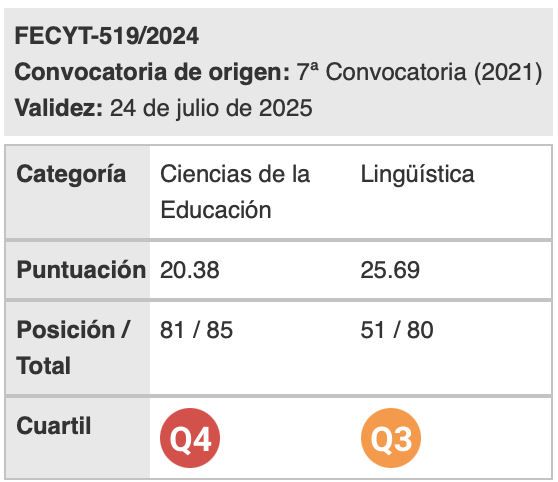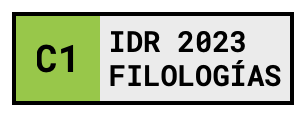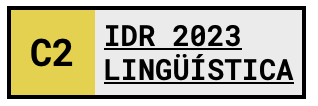ARTEMIS: State of the Art and Future Horizons
Palabras clave:
Natural Language Processing, ARTEMIS, FunGramKB, computational grammar, Role and Reference GrammarResumen
The syntactic parser ARTEMIS (Automatically Representing Text Meaning via an Interlingua-based System) is a prototype intended to process natural language within the environment of the Functional Grammar Knowledge Base (FunGramKB) (Periñán-Pascual & Arcas-Túnez, 2010). Different from other parsing devices, ARTEMIS is grounded on two functional linguistic models: Role and Reference Grammar (RRG) (Van Valin & La Polla, 1997; Van Valin, 2005) and the Lexical Constructional Model (LCM) (Ruiz de Mendoza & Mairal Usón, 2008). However, certain adjustments have to be made to both models in order to meet the requirements derived from the fact that ARTEMIS follows the paradigm of Unification Grammars, in such a way that to comply with this paradigm, the GDE (Grammar Development Environment) within ARTEMIS needs to integrate two types of constructs: a catalogue of Attribute-Value Matrixes (AVMs) to describe grammatical units, and a set of production rules (grammatical, lexical and constructional) to allow it to produce a feature based grammar. It is the aim of this paper to give an overview of the investigation carried out so far within ARTEMIS in relation to these two aspects. We will do so by revisiting the literature in relation to the adjustments made to the linguistic models, especially to the RRG, and by reviewing the efforts made to describe the units and design the rules necessary for the parsing of simple sentences in English. Our paper will conclude by pointing at prospective research needed for the completion of this project.
Descargas
Citas
Boas, H. & Sag, I. (2012). Sign-Based Construction Grammar. Stanford, Cal.: CSLI Publications.
Cortés-Rodríguez, F. (2016a). Parsing simple clauses within ARTEMIS: The computational treatment of the layered structure of the clause in Role and Reference Grammar. 34th International Conference of AESLA. Alicante, 14-16, April 2016.
Cortés-Rodríguez, F. (2016b). Towards the computational implementation of RRG. Círculo, 65, 75-108.
Cortés Rodríguez, F. & Mairal-Usón, R. (2016). Building an RRG computational grammar. Onomazein, 34, 86-117.
Díaz Galán, A. & Fumero Pérez, M. (2016). Developing parsing rules within ARTEMIS: The case of Do auxiliary insertion. In C. Periñán-Pascual & E. Mestre-Mestre (Eds.), Understanding meaning and knowledge representation: From theoretical and cognitive linguistics to natural language processing (pp. 283-302). Cambridge: Cambridge Scholars Publishing.
Ferrari, G. (2004). State of the art in computational linguistics. In P. Van Sterkenburg (Ed.), Linguistics today: Facing a greater challenge (pp. 163-186). Amsterdam / Philadelphia: John Benjamins.
Fumero Pérez, M. & Díaz Galán, A. (2017). The Interaction of parsing rules and argument-predicate constructions: Implications for the structure of the Grammaticon in FunGramKB. Revista de Lingüística y Lenguas Aplicadas 12, 33-44.
Luzondo-Oyón, A. & Ruiz de Mendoza, F. (2015). Argument structure constructions in a natural language processing environment. Language Sciences 48, 70-89.
Mairal-Usón, R. & Cortés-Rodríguez, F. (2017). Automatically representing TExt Meaning via an Interlingua-based System (ARTEMIS). A further step towards the computational representation of RRG. Journal of Computer-Assisted Linguistic Research 1(1), 61-68.
Mairal Usón, R. & Periñán-Pascual, C. (2009). The anatomy of the Lexicon within the framework of an NLP knowledge base. RESLA 22, 217-244.
Mairal Usón, R. & Periñán-Pascual, C. (2016). Representing constructional schema in the FunGramKB Grammaticon. In J. Fleischhauer, A. Latrouite & R. Osswald (Eds.), Explorations of the syntax-semantics interface (pp. 77-108). Düsseldorf: Düsseldorf University Press.
Mairal Usón, R. & Ruiz de Mendoza Ibáñez, F. (2009). Levels of description and explanation in meaning construction. In C. Butler & J. Martín Arista (Eds.), Deconstructing constructions (pp. 153–198). Amsterdam / Philadelphia: John Benjamins.
Martín Díaz, M. A. (2017). An account of English yes/no interrogative sentences within ARTEMIS. Revista de Lenguas para Fines Específicos, 23(2), 41-62.
Periñán-Pascual, C. (2012). En defensa del procesamiento del lenguaje natural fundamentado en la lingüística teórica. ONOMÁZEIN, 26(2), 13-48.
Periñán-Pascual, C. (2013). Towards a model of constructional meaning for natural language understanding. In B. Nolan & E. Diedrichsen (Eds.), Linking constructions into Functional Linguistics: The role of constructions in RRG grammars (Studies in Language Series) (pp. 205-230). Amsterdam / Philadelphia: John Benjamins.
Periñán-Pascual, C. & Arcas-Túnez, F. (2010). The Architecture of FungramKB. In Proceedings of the 7th International Conference on Language Resources and Evaluation (ELRA), (pp. 2667-2674). Malta: European Language Resources Association.
Periñán-Pascual, C. & Arcas-Túnez, F. (2014). The implementation of the CLS constructor in ARTEMIS. In B. Nolan & C. Periñán-Pascual (Eds.), Language processing and grammars. The role of functionally oriented computational models (pp. 164-196) Amsterdam / Philadelphia: John Benjamins.
Periñán-Pascual, C. & Mairal Usón, R. (2009). Bringing Role and Reference Grammar to natural language understanding. Procesamiento del Lenguaje Natural, 43, 265-273.
Rodríguez-Juárez, C. On the computational treatment of constructions: the place of locative constructions in a knowledge base. In press.
Ruiz de Mendoza Ibáñez, F. (2013). Meaning construction, meaning interpretation and formal expression in the Lexical Constructional Model. In B. Nolan & E. Diedrichsen (Eds.), Linking constructions into Functional Linguistics: The role of constructions in RRG Grammars (Studies in Language Series) (pp. 231-270). Amsterdam / Philadelphia: John Benjamins.
Ruiz de Mendoza Ibáñez, F. & Mairal Usón, R. (2008). Levels of description and constraining factors in meaning construction: An introduction to the Lexical Constructional Model. Folia Linguistica, 42(2), 355-400.
Sag, I, Wasow, T. & Bender, E. (2003). Syntactic theory: Formal introduction. Stanford: CSLI Publications.
Van Valin, R. (2005). Exploring the syntax-semantics interface. Cambridge: Cambridge University Press.
Van Valin, R. (2008). RPs and the nature of lexical and syntactic categories in Role and Reference Grammar. In R.D. Van Valin, Jr. (Ed.), Investigations of the syntax-semantics-pragmatics interface (pp. 161-178). Amsterdam / Philadelphia: John Benjamins.
Van Valin, R. & LaPolla, R. (1997). Syntax. Cambridge: Cambridge University Press.
Descargas
Publicado
Cómo citar
Número
Sección
Licencia
Aquellos autores/as que tengan publicaciones con esta revista, aceptan los términos siguientes:
- Los autores/as conservarán sus derechos de autor y garantizarán a la revista el derecho de primera publicación de su obra, el cuál estará simultáneamente sujeto a la Licencia de reconocimiento de Creative Commons que permite a terceros compartir la obra siempre que se indique su autor y su primera publicación esta revista.
- Los autores/as podrán adoptar otros acuerdos de licencia no exclusiva de distribución de la versión de la obra publicada (p. ej.: depositarla en un archivo telemático institucional o publicarla en un volumen monográfico) siempre que se indique la publicación inicial en esta revista.
- Se permite y recomienda a los autores/as difundir su obra a través de Internet (p. ej.: en archivos telemáticos institucionales o en su página web) antes y durante el proceso de envío, lo cual puede producir intercambios interesantes y aumentar las citas de la obra publicada. (Véase El efecto del acceso abierto).

Revista de Lenguas para fines específicos is licensed under a Creative Commons Reconocimiento-NoComercial-SinObraDerivada 4.0 Internacional License.






















